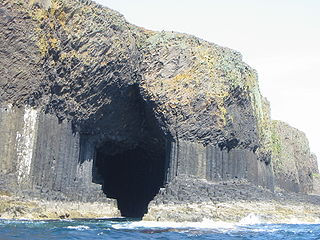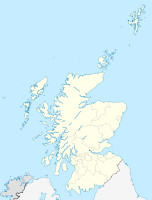- Fingal’s Cave
-
Fingal’s Cave Fingal’s Cave im Juli 2004
Lage: Staffa, Schottland Höhe: 23 m Geographische Lage: 56° 26′ 2″ N, 6° 20′ 10″ W56.433889-6.33611123Koordinaten: 56° 26′ 2″ N, 6° 20′ 10″ W Geologie: Basalt Entdeckung: 1772 Gesamtlänge: 85 m Fingal’s Cave (schottisch-gälisch: Uamh-Binn) ist eine 85 Meter lange Höhle auf der unbewohnten schottischen Insel Staffa. Sie besteht zum größten Teil aus sechseckigen Basaltsäulen, die im Tertiär entstanden sind. Neben dem Giant’s Causeway in Nordirland ist sie eine der bekanntesten Basaltformationen des Vereinigten Königreichs.[1]
Inhaltsverzeichnis
Geschichte
Fingal’s Cave wurde im August 1772 von Joseph Banks, einem englischen Naturforscher, auf dem Weg zu einer Expedition nach Island entdeckt.
Die Höhle ist nach dem angeblichen Sagenhelden Fingal benannt, der in Wirklichkeit vom schottischen Schriftsteller James Macpherson erfunden wurde. Macpherson ließ in seinen Fragments of Ancient Poetry den fiktiven Dichter Ossian – angelehnt an den mythischen irischen Dichter Oisín – von den Heldentaten des Königs Fingal berichten, dessen Vorbild der irische Sagenkrieger Fionn mac Cumhaill war.
Tourismus
Im 19. Jahrhundert galt Fingal’s Cave als Touristenattraktion; es landeten bis zu 300 Touristen am Tag auf Staffa, um die Höhle zu besichtigen. Berühmte Besucher waren zum Beispiel Königin Victoria, Walter Scott, John Keats, Theodor Fontane und William Wordsworth. Der rege Bootsverkehr zur Insel ist heutzutage weitgehend eingestellt.
Martin Mills von der Grampian Speleological Group bezeichnet die Höhle als „most famous but least visited cave in the world“ („berühmteste, jedoch am wenigsten besuchte Höhle der Welt“).[2] Er spielt hier darauf an, dass zwar viele Schiffe und Boote mit Touristen an Bord Staffa passieren, jedoch nur wenige tatsächlich dort vor Anker gehen. Lediglich einige kleinere Boote von Mull und Iona, den Nachbarinseln, fahren Staffa heute noch an.
Die Höhle in der Kunst
Am 8. August 1829 besuchte der deutsche Komponist Felix Mendelssohn Bartholdy die Insel Staffa und auch Fingal’s Cave. Inspiriert durch den Aufenthalt, komponierte er eine Ouvertüre, der er den Titel Die Hebriden gab.
Der romantische Maler William Turner malte im Jahr 1832 den Eingang der Höhle; das fertige Gemälde nannte er Staffa, Fingal’s Cave (siehe Abschnitt „Weblinks“). Es wurde von der Royal Academy of Arts in London als „one of the most perfect expressions of the romanticism style of art“ („eines der perfektesten Werke der Romantik“) bezeichnet.[3] Heute befindet sich das Gemälde im Yale Center for British Art in New Haven.[4]. Der deutsche Arzt, Naturwissenschaftler und Romantiker Carl Gustav Carus malte den Blick aus der Fingalshöhle bei Mondschein um 1851 (Kupferstichkabinett Dresden, Inv.-Nr. C 1963-4)[5]
Bilder
-
Fingal’s Cave auf einem Photochromdruck (um 1900)
Einzelnachweise
- ↑ Show Caves of the World
- ↑ In: GSG Bulletin, Bd. 3, Nr. 1, 1994. Mills gebraucht „famous“ in der Bedeutung von „oft in der Fachliteratur vertreten“.
- ↑ Dundee Satellite Receiving Station
- ↑ Yale Center for British Art
- ↑ Carl Gustav Carus: Natur und Idee. Deutscher Kunstverlag, Berlin 2009. ISBN 978-3-422-06880-3.
Weblinks
- Informationen über die Höhle (englisch)
- William Turner: Staffa, Fingal’s Cave (englisch)
- William Wordsworth: Cave of Staffa (englisch)
Wikimedia Foundation.





